Don't wanna be here? Send us removal request.
Text
Saddest thing ever is reading an academic paper about a threatened or declining species where you can tell the author is really trying to come up with ways the animal could hypothetically be useful to humans in a desperate attempt to get someone to care. Nobody gives a shit about the animals that “don’t affect” us and it seriously breaks my heart
173K notes
·
View notes
Text
I haven't talked reptiles in Wet Beast Wednesday in a while (and the first time I did it got like 9 notes) so I'll do it again with marine iguanas. Admittedly they're more amphibious than aquatic, but there's no Moist Beast Monday and I think they're cool so it'll have to do.
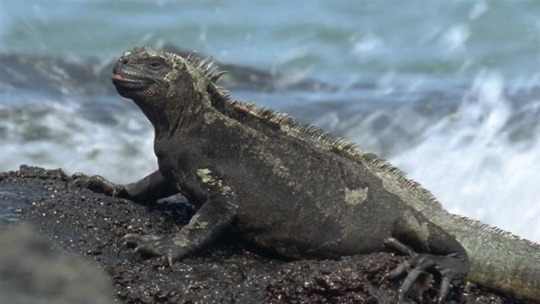
(Image: Doug Jones in The Shape of Water a marine iguana basking on a rock)
Marine iguanas (Amblyrhynchus cristatus) are large lizards native to the Galapagos Islands. They are unique for being the only extant lizards that spend time in the ocean. As of 2017, there are 11 distinct subspecies that are isolated from each other by the islands they live on. Occasionally a member of one subspecies will end up on the wrong island and produce hybrid offspring. Marine iguanas also can but very rarely do hybridize with the land iguanas of the Galapagos, with whom they are believed to share a common ancestor.
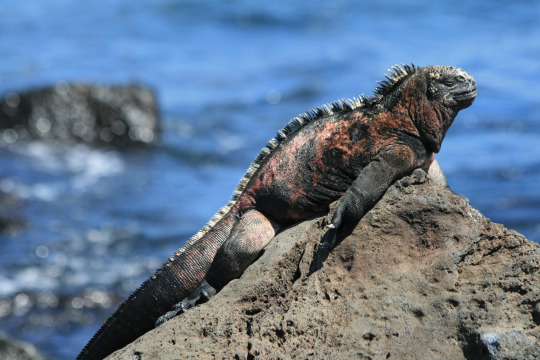
(Image: an iguana perched on a rock
Marine iguanas vary in size based on subspecies, with those from smaller islands reaching a smaller adult size. In general, they race from 12 to 56 cm (4.7 - 22 in) from snout to rear, with a tail ranging from 17 to 84 cm (6.7 - 33.1 in). Males are significantly larger than females, up to twice the weight and noticeably longer. Marine iguanas are robust, with relatively short limbs. Their leg bones are heavy, to provide ballast while swimming. Their tails are laterally flattened and provide propulsion for swimming. They have a row of spines down their backs that provide stability while swimming, similar to a fish's dorsal fin. Their feet have powerful claws and can be used to cling onto and push off of undersea rocks. Marine iguanas were noted by many explorers for their dark color, including Charles Darwin (who referred to them as "clumsy" and "disgusting"). This dark color helps them warm up quickly after diving in the sea.

(image: an iguana going for a swim)
A major feature of the marine iguana is its diet, which is a huge factor in their semiaquatic lifestyle. They feed almost exclusively on green and red algae that grown underwater. To reach the algae, females and smaller males browse the intertidal zone during low tide, while larger males and abnormally large females can swim out to the deeper subtidal zone to forage. They can spend an hour underwater one one breath and dive to 30 m (98 ft), but most dives are much shallower and shorter. Only the largest males swim offshore and dive to significant depths for their food. Because they are positively buoyant, divers must actively swim or cling onto rocks to stay underwater. Most individuals will return to the same spot for feeding and competition over feeding spots have been known to happen. Larger males that swim out for their food have the advantage of less competition for their feeding spots. The species has adapted to be able to fast or subsist on reduced for long periods. During El Nińo, where food supplies can be reduced for years, they will actually shrink, with even their bones getting shorter, then return to full size once the food supply is restored. Because they consume excess salt with their food, marine iguanas have developed the ability to filter the salt out of their blood and expel it through glands in their nostrils. The secreted salt can then be sneezed away. Juveliles spend the first few months of their life feeding on (WARNING: GROSS) the feces of older iguanas. This helps them develop the culture of symbiotic gut bacteria that helps them digest algae. In fact, their digestive systems are so specialized to algae that they can't switch diets.

(image: a marine iguana grazing on algae underwater)
As ectotherms (cold-blooded animals), marine iguanas need to keep themselves warm to survive. The water around the Galapagos is typically around 11-23 degrees C (52-75 F) while their preferred body temp is 35-39 C (95-102 F). This high preferred temperature helps with their digestion. To keep themselves warm, the iguanas spend a lot of their time basking in the sun, especially after swimming. They can also reduce their heart beats while cold to help prevent heat loss. Basking iguanas can cover large beaches. They live in colonies that usually range between 20 and 500 individuals but can sometimes get up to 1000 members. Their biomass to area ratio can be the highest of any reptile. While they are considered gregarious, they display no social behavior such a grooming. The closest they get to a group activity is sleeping next to each other to conserve heat at night. They also get along with other species, such as Darwin's finches, mockingbirds, and crabs who will pick parasites off their skin. Divers may allow cleaner fish to pick off bits of dead skin. Another lizard, the lava lizard, likes to visit colonies to hunt flies attracted to the iguanas. The iguanas allow the much smaller lizards to climb all over them. Marine iguanas often share beaches with Galapagos sea lions, who will occasionally allow the iguanas to climb over them.
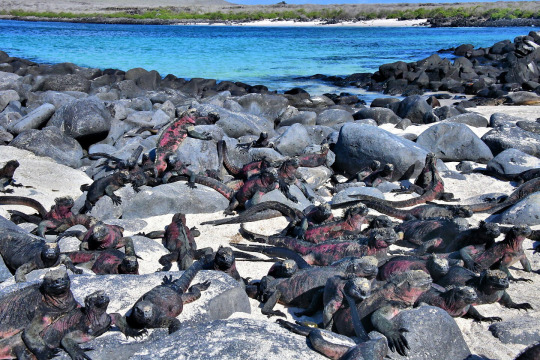
(image: a group of iguanas basking together)
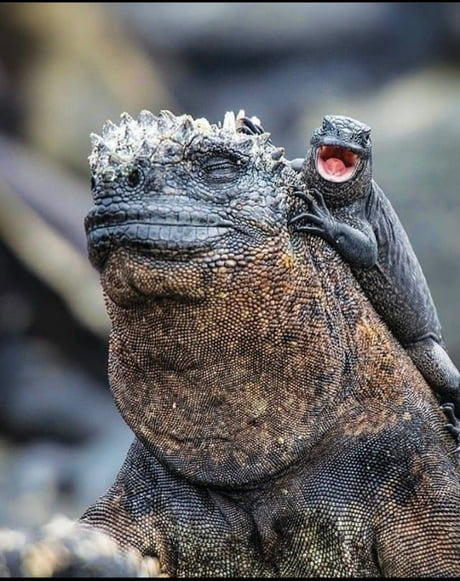
(image: a male marine iguana, identifiable by the rough scales on his head, with a lava lizard climbing on him)
During mating season, male iguanas stop being as chill with their neighbors, attempting to establish a territory and push other males out. They also change from their normal dark appearance to a much brighter coloration. Territories are usually bordered by rocks or crevasses and can be found next to each other in groups. Males will attempt to attract females to their territories while fighting other males to get access to their females. This behavior is called lekking. Females show a distinct preference for larger males and it is the largest males that are most successful at maintaining territories. Medium males are forced to patrol the edges of territories to try to pick up mates while small males often pretend to be female to sneak into another's territory and attempt to mate. Males with territories defend them with special displays where they will raise their dorsal spines and open their mouths while bobbing their heads around. If another male challenges the dominant, they will display at each other. If neither submits, a fight will start. Males fight by headbutting and trying to push each other around. These fights can last for hours and the participants will occasionally take breaks. In most cases, one will eventually display a submissive posture and retreat, though in a few cases the fight has escalated to biting and scratching. When courting a female, a male will nod at her and approach in a sideways walk. Smaller males without territories may also try mating forcibly. Females only mate once per year and will signal rejection to additional suitors by nodding at them.
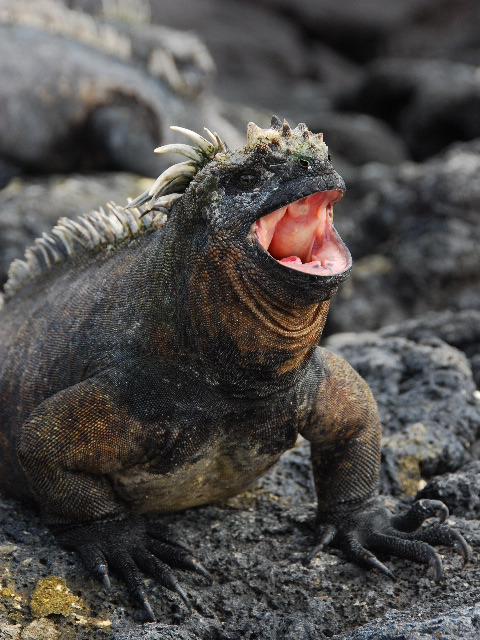
(image: a male performing a territorial display)
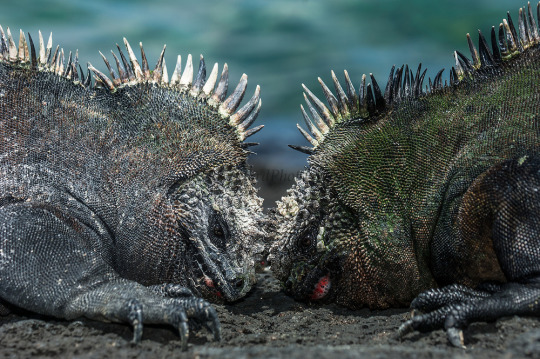
(image: two males headbutting each other in a territorial battle)
Mating season usually lasts between December and March. Females will lay eggs about a month after mating. The eggs (usually 2 to 3 but sometimes up to 6) can collectively weigh up to a quarter of the mother's weight, which is very large for an iguana. They are laid well above the tide line and buried in sand or soil. In places with few good nesting sites, mothers will guard their eggs after hatching to make sure other females don't dig therm up to steal the spot. When females fight over nesting spots they are less disciplined than males and will quickly resort to biting. The eggs hatch after 3-4 months. Females reach sexual maturity after 3-5 years while males do so after 6-8 years. They live an average lifespan of 12 years, but can live up to 60.
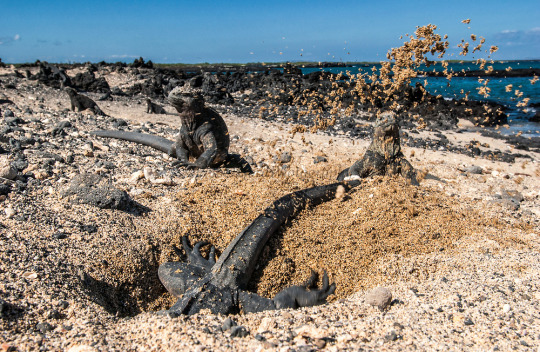
(image: a female iguana digging her nest)
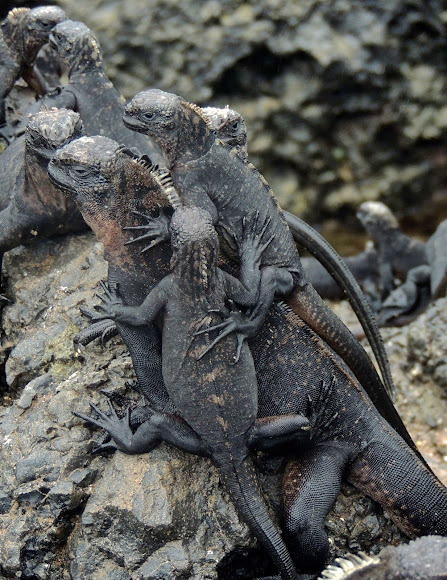
(image: a group of juveniles climbing on each other)
Marine iguanas are classified as vulnerable by the IUCN, while a few populations are instead considered endangered. A major threat to them is warming seas, which can reduce the red and green algae populations and replace them with inedible brown algae, leading to starvation. Marine iguanas only have a few predators and most of them target juveniles or small adults. As a result, the adults demonstrate island tameness, a lack of wariness to potential predators. This has left them vulnerable to predators introduced by humans, such as dogs, cats, rats, and pigs. Despite these invasive predators being present for ver 100 years, they have not developed any anti-predator defenses against them, a phenomenon called ecological naïveté. They also do not fear humans and will allow tourists to approach them, which has led to injuries and the spread of human-introduced diseases. They are protected by laws of Ecuador and most of their range is in protected areas. Efforts to remove invasive predators have seen some benefit. They are difficult to keep in captivity due to their specialized diets, and they have never been bred in captivity.
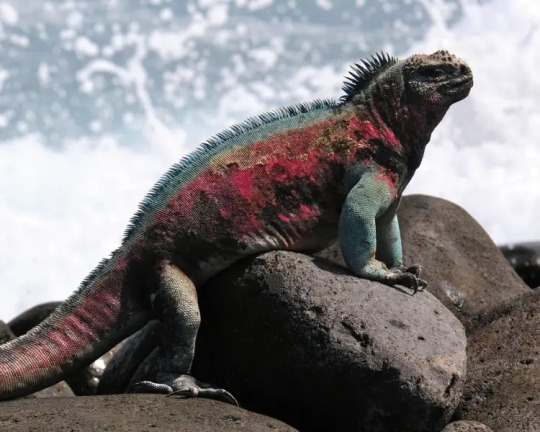
(image: a male with his bright mating season coloration)
212 notes
·
View notes
Text
[ID: a photo of a newspaper posted by Dr Charlie Gardner with the title 'Happy 111'th birthday to this little one!'. The newspaper was published August 12th 1912. It reads: Science notes and news. Coal consumption affecting climate. The furnaces of the world are now burning about 2,000,000,000 tons of coal a year. When this is burned, uniting with oxygen it produces about 7,000,000,000 tons of carbon dioxide to the atmosphere yearly. This tends to make the air a more effective blanket for the earth and to raise it's temperature. The effect may be considerable in a few centuries. END ID]

89K notes
·
View notes
Text
Cute but underappreciated animals
Gharials! They look like they're either laughing at their own terrible jokes or trying hard not to. So much dad energy.
Goblin sharks! Most images of them are of dead individuals, so they look wrinkled and scary. But they're just weird little guys and I honestly love them so much.
Telescope fish! Some images of them are from an especially unflattering angle, but they're goofy little things so I don't think they mind it. They have extendable jaws and they do not know what capitalism is.
Archey's frog! It is literally just walking moss in the shape of a friend. I honestly cannot look at them without squealing.
Tragically, gharials are critically endangered with fewer than 235 individuals remaining. The Gharial Conservation Alliance (GCA) is working to preserve this precious crocodilian - if you want to help, you can make a donation or try to raise awareness in whatever way you can
#gharial#crocodilian#goblin shark#shark#telescope fish#deep sea creatures#archey's frog#frogs#gharial conservation alliance#wildlife#endangered animals
2 notes
·
View notes
Text
How hearing aids work
This is intended as a writing guide, but anyone is welcome to read it to learn more about the different aids used by deaf people.
Please remember that these are based off my experience as somebody who was born deaf in the uk. Other deaf people will have vastly different experiences, and I would encourage you to look up other guides like this
Hearing aids are not always available, particularly if you live in a country without free healthcare. They can be very expensive, both to buy and to take care of
If your character is a deaf child or young teenager, they will need new hearing aid moulds every so often as their ears grow. This only involves going to the hospital for a few hours, and isn't really a big deal. You can get different colours of mould, sometimes sparkly ones, or with tiny embedded designs
Hearing aids cannot get wet, so we take them off to shower, swim, etc. We also take them off to sleep
Hearing aids do not fix hearing loss, and many deaf people still need to lipread and use sign language while wearing them. Please don't try to compare them to glasses!
Some people choose not to wear hearing aids at all, which is a perfectly reasonable and valid decision. Sometimes it is too overwhelming to be exposed to so much noise, sometimes people just prefer to sign or use other non-verbal communication
Not all people with hearing aids know or use sign language
If your character is wearing hearing aids for the first time, they will probably become a lot clumsier while they get used to it
That's all I can think of for now! To any hearing writers reading this, I'm glad you're making an effort to write diverse characters thoughtfully and respectfully!
714 notes
·
View notes
Text
Great Crested Newt
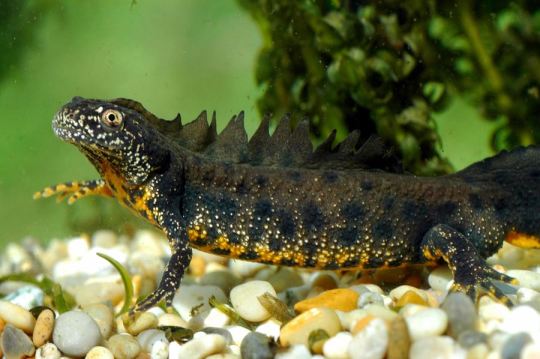
[ID: A photo of a great crested newt (a dark brown newt with a yellow belly, black spots and a dramatic crest along it's back). It is standing underwater on a pebbly surface with green pondweed visible in the background END ID]
Habitat: Found in Russia and much of Europe, the great crested newt prefers to live in forests outside of the breeding season.
Diet: Mostly invertebrates and the young of other amphibians
Why they're cool:
Male great crested newts will perform a complex courtship display involving tail-flapping to wave pheromones towards a female. They are the largest newts in Europe with females regularly reaching lengths of 16cm, though rare individuals have been recorded at up to 20cm long
1 note
·
View note
Text
Epaulette Shark

[ID: A photo of an epaulette shark (A small, sandy brown shark with large black spots) in a rocky, terrestrial environment surrounded by puddles of seawater]
Habitat: Shallow water around northern Australia, Papua New Guinea and West Papua
Diet: Crustaceans, worms, smaller fish
Why they're cool:
Epaulette sharks are able to survive extreme oxygen deprivation, and can live for as long as one hour with no oxygen at all. This enables them to move across land for short periods of time and hunt in oxygen-poor rockpools
24 notes
·
View notes
Text
Things I love about being Deaf
The community! I've met so many lovely people in the Deaf community, and I can't express how important it was for me to meet other deaf individuals
The language. I am learning BSL, and it is something that I would reccomend to anyone, not just deaf people. Have you ever needed to communicate across a noisy room? It's so helpful and it blows my mind that sign language isn't usually taught in schools
My hearing aids. I am lucky enough to live in a country where hearing aids are free, and I know that a lot of people do not have access to them like I do. That said, it warms my heart to see people with hearing aid accessories, brightly coloured aids, etc. Mine are bright blue, and I love showing them off!
The ability to mute people. Noisy environment? People being unkind? Switch the hearing aids off and BAM! No sound, no problem.
I am now legally required to say DEAFinitely instead of definitely for the rest of my life.
#deaf#deafawareness#deaf awareness#deafpride#deaf pride#BSL#british sign language#hearing aids#deaf positivity
46 notes
·
View notes
Text
Secretary birds

[ID: A photo of a secretary bird (A tall, grey raptor with black legs and tail, orange facial markings and long, black head feathers) walking through a rocky environment. END ID]
Habitat: Grasslands of sub-Saharan Africa
Diet: Insects, small mammals and snakes
Why they're cool:
My favourite thing about secretary birds is their fascinating hunting strategy. By kicking and stamping at the heads of their prey, they can bring down snakes. They have even been rumoured to have attacked small antelope and juvenile cheetah, however, I wan unable to find enough information to confirm this.
8 notes
·
View notes
Text
Introduction
This is a blog dedicated to two things - animals and deaf awareness. I have been hearing impaired my whole life, and I started this blog to increase understanding of deafness and combat misconceptions and negative stereotypes
A few notes on my blog:
I will do everything I can to make sure that any facts are correct. If you notice any mistakes I have made, please tell me!
Feel free to submit questions in my ask box, but please don't ask me anything personal or unrelated to my blog
I want this blog to be as accessible as possible - if you think there is anything I can improve on (e.g. different image descriptions, fonts, etc), please let me know :)
With that aside, enjoy this blog!
1 note
·
View note